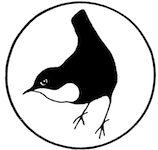The Evans magic worked again. The weather forecast said heavy cloud and cold winds off the North Sea and hinted at something even worse. The reality was broken cloud, bursts of sunshine and a gentle breeze. So eighteen members were able to explore Alkborough Flats without streaming eyes and without clinging on to wind-rocked telescopes.
The Flats are well named. The Lincolnshire Wolds end abruptly with a few houses and a church and then, where the Trent meets the Humber, the land tumbles down to an expanse of reed and marsh and lagoons. The paths through the reeds are raised and well maintained; the hides solid and cleverly sited.
Most of the birds listed were seen, but some, like the Cettis Warbler, only heard. Just a few years ago the news of a Cettis this far north would have had the twitchers flocking. Now we put it on the list along with the Little Egret and move on.
Also more vocal than visible was the Water Rail, doing its imitation of an outraged pig.
Three Marsh Harriers seemed to be sharing a narrow strip of territory, rising and falling and getting in each other’s way. Once it appeared that two of them had had a mid-air collision but perhaps it was just something that Marsh Harriers do. But at least they were easy to watch.
Not like Bearded Tits. A bright flash as they flit from one reed to an identical one and they have gone before you can raise your binoculars.
But, for me at least, the highlight of the day was the view from one hide of ducks and waders spread over the water and mud banks of a lagoon like an illustration of a ‘Teach Yourself Bird Recognition’.
How many? Difficult to say. A single Heron, a few Curlew and Ruff, dozens of other species of duck and wader as well as a hundred-plus Lapwing and even more Golden Plover. But other people may have counted more. And the surprising thing, to me at least, was how colourful they were. No winter drab yet. The Golden Plover still had golden flecks and the Lapwing still had bright heads and a greenish sheen.
Every now and again, for no apparent reason, the Golden Plover would take off, fly around in a tight flock then land again while everything else ignores them and gets on with dabbling and probing.
Just before leaving the marshes, as seventeen members were peering down a drain in search of an elusive Water Rail, the lucky eighteenth was the sole witness of the classic panic of the ducks and the waders as a Peregrine passed overhead.
And finally, by some thoughtful management, the mini-bus was waiting at the foot of the hill and sixteen*grateful members were saved a long wearisome climb. (*Two of our number came by car).
Thanks for a smooth ride to the driver who happened to be a birdwatcher and brought his own telescope (perhaps we should have charged him) and to Stuart Slack for instant recognitions, both seen and heard, (sometimes of things that only he has seen or heard) and most of all to Dorothy for seamless arrangements.
Species seen
Continue reading →
